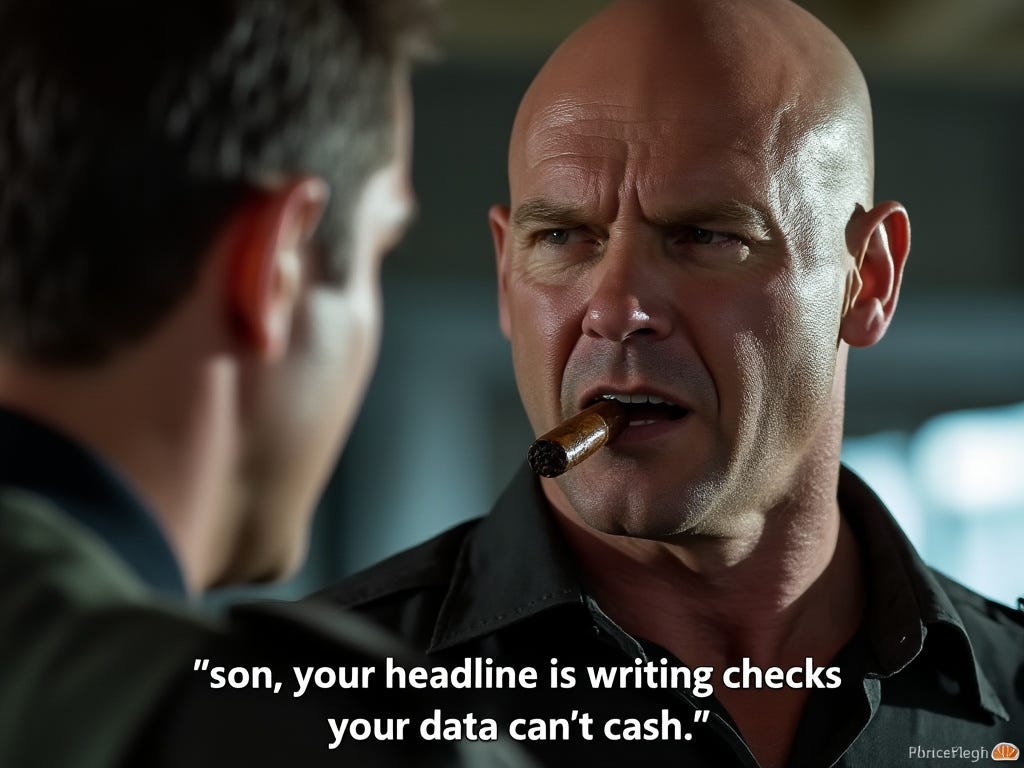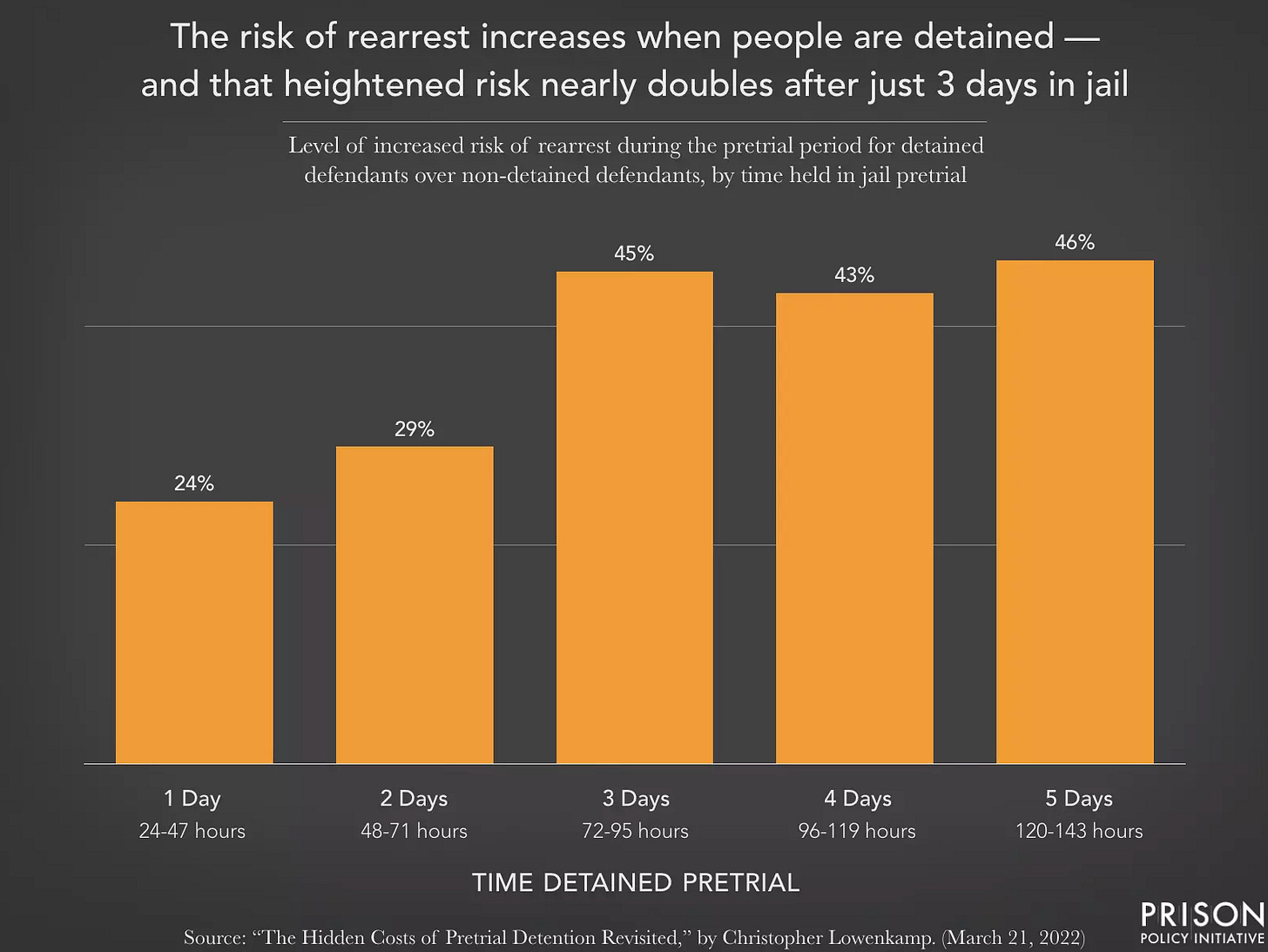RePath Round Up--A Definitive Answer on Bail Reform and Public Safety
One day in jail, no cash Indiana, and 1,300 complaints in Chicago
The final answer on bail reform: The Brennan Center for Justice released a long and detailed bail reform report yesterday and makes a bold claim—”Data from 33 cities across the country discredits the claim that bail reform causes crime to increase.” Since this issue has been fiercely debated for the better part of a decade, it is nice to have such a simple, definitive answer. And you will have that comforting answer as long as you choose not to read any part of the report, the methodology, or do any research on your own. But for the rest of us . . .
The Brennan Center is a progressive non-profit that is ideologically disposed to support bail reform. While there is nothing inherently wrong with its partisanship and many of its claims may be broadly correct, it is a bit over its skis in its grand pronouncement on bail reform. This is evident from the text itself. Where the Center claims to discredit any connection between bail reform and crime, the report and methodology supplement reveal:
that it simply didn’t report a meaningful correlation between certain specific crimes and bail reform connected to its limited analysis of a limited sample over a limited period of time across varying jurisdictions after it made adjustments to the data.
that it only reviewed 6 types of crimes (which were often unrelated to the bail reform at issue and represent only a fraction of the actual reported crimes in each city)
that it ignored a number of misdemeanor crimes, including failures to appear
that the bail reforms were not the same across the study
that the crime data was limited
that the reforms in the different cities were implemented with various completeness across different timelines
that the data was collected from different databases that don’t mirror each other in classification and data coding
that in some areas (ahem, New York), the study compared new bail reforms against existing bail reforms, rather than bail reform against no bail reform
that the study altered the results using a “difference-in-differences” strategy to account for additional variables chosen by the Center
that the study declined to include control variables relating to reduced prosecution of certain crimes by prosecutors
that the study does not account for metrics such as arrests and clearance rates
that the study is limited to 22 reform cities and does not include many other jurisdictions that have implemented bail reform
that the study “obscures the experience of individual jurisdictions” and does not contradict findings in specific jurisdictions that do find a connection between crime and bail reform
that study is limited in time and does not consider the impact of bail reform over the long term or even a period of several years.
More specifically, the report often analyzes felony crime rates in cities based on bail reform for misdemeanors. In doing so, it doesn’t evaluate the actual total crime rate, failures to appear, or the impact of bail reform on crime in adjacent jurisdictions.
None of this means that the study has no value. It does have value and it is worthy of consideration with a proper understanding of its design, limitations, and the bias of its authors and publisher. But the Brennan Center is staffed with smart people who know better than to claim that this study “discredits” all claims connecting bail reform with increased crime. While it is a nice headline and it fits on an X post, this claim is simply irresponsible.
One Day in Jail: The Prison Policy Initiative claimed last week that even a single day in jail has a long term negative impact on those detained. This conclusion is largely based on a long term study analyzing 1.5 million individuals booked in Kentucky jails between 2009 and 2018. Kentucky has a total population of 4.5 million individuals. The study found:
increasing time spent in pretrial detention did not increase or decrease failure to appear rates
increasing time spent in pretrial detention was associated with increased odds of rearrest
pretrial release is associated with a lower likelihood of receiving a sentence to incarceration and when sentenced to incarceration receive a shorter sentence.
While the findings are intriguing, the study does not consider 1) the nature or quality of post-release supervision; or 2) whether increased detention is related to the crime charged or the defendant’s past criminal history.
Oh Mickey, you’re so fine, you’re so fine you blow my mind, what’s an arbitration clause?: The Disney Corporation is attempting to dismiss a wrongful death lawsuit stemming from an allergic food reaction at a Disney park because the victim signed up for Disney+ from a playstation account years earlier. What? The claim from Disney is that an arbitration clause in the digital subscription service strips any member of the ability to sue any Disney entity or affiliate in any American court for any claim or injury. The plaintiff called the claim “preposterous” and said it was absurd that 153 million subscribers to the digital service could have waived all claims against Disney. The court has yet to rule on Disney’s motion to dismiss.
You can’t smell Bitcoin: A new lawsuit claims that the State of Indiana is illegally seizing millions in cash from FedEx packages every year. Apparently, the scheme goes like this—FedEx has a massive distribution center in Indianapolis, the state employs a canine unit to identify packages that may contain cash, the Marian County prosecutor’s office then seeks to keep the cash it finds under the legal theory of civil asset forfeiture by alleging that the cash was connected to a crime but does not identify any actual crime committed or contemplated. The lawsuit claims that this scheme violates a wide range of constitutional rights, including the 4th, 8th, 10th, and 14th amendments.
A growing economy in Chicago: Over a 5 year period, the City of Chicago spent nearly $400 million to investigate and resolve lawsuits alleging misconduct from 1,300 Chicago police officers. City taxpayers footed the bill in settlements, damages, lawyer fees, and other payouts. 200 repeat offenders accounted for $164.3 million of the cost.
Stranger Stuff
The Silver Briefcase: Mississippi attorney Daniel Dale’s magic silver briefcase allegedly held all the items he was charged with smuggling into a Hinds County jail this week. Items included cell phones, a digital scale, cigarettes, weed, chargers, and cigars. You are under no obligation to check out his mugshot.
Food for Cops: A former Safeway employee was fired for giving fried chicken and deli sandwiches to police working shoplifting stings at the store. He is suing for $20 million.
Playskool Tracker: An Australian bail service provider is facing 27 charges including perjury and installing a fake gps tracker on a gangland figure.
High Value Targets: A Florida man was arrested on terrorism charges after leaving letters threatening to blow up a solar generation facility, a McDonalds, and two different Starbucks.
Cartel Law: Prior to traveling to the U.S. in a private plane to turn himself into authorities, cartel boss Joaquin Guzman Lopez kidnapped Sinaloa cartel leader “El Mayo” and brought him along. U.S. authorities are happy for their double good fortune, but Mexican authorities are threatening to charge Lopez with treason for “illegally abducting a person in Mexico in order to hand them over to authorities of another country.” Who could even manage such an operation.







